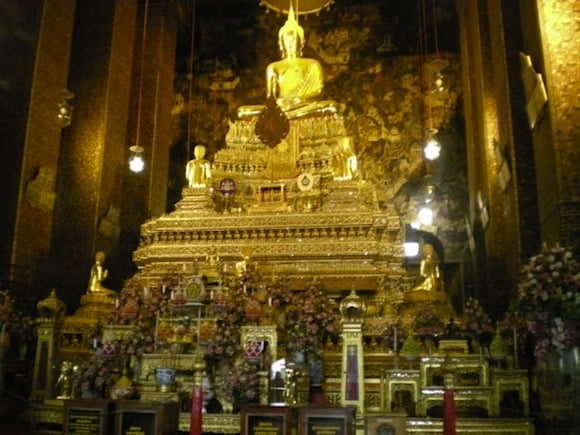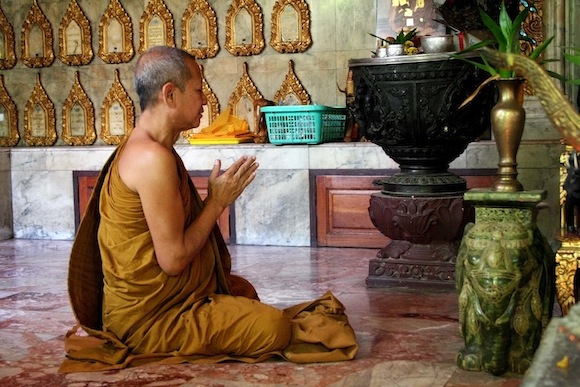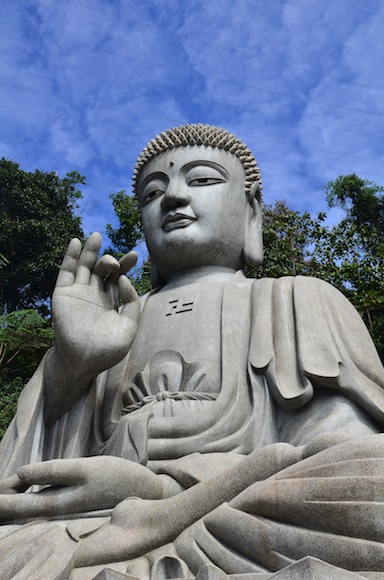
- Sweat trickles down my neck and runs down the small of my back as I desperately try to shake my loose t-shirt and create a breeze. It doesn’t help that it’s unacceptable in Thailand – especially in a temple – to show your shoulders or knees. Above image: shirleybmz.
I groan as yet another person steps on my foot. There are about 500 tourists packed into Wat Po, one of Bangkok’s most famous temples. I want to punch them all as they squish against me, trying to shimmy their way past me. Can’t they just wait a second? As my anger rises I realize that I am beginning to sweat even more.
That’s when I remember where I am. Thailand, where the dominant religion and outlook on life is Buddhism, a moral code of peace and harmony.
My heart rate begins to lower as I force a smile on my face and begin to talk myself through a positive attitude. I decide that in order to have an authentic experience I am going to live as the locals do and have as much of a Buddhist experience as possible. And in Thailand, there are many opportunities for this.

Visiting Temples
“This is the giant reclining buddha,” explains Jaeb, my GAdventures tour guide. The statue is over 150 feet long and about 50 feet high, gilded in gold, and fills the Wat Po temple in Bangkok. On the feet of the enormous Buddha are mother-of-pearl illustrations depicting the life of Buddha. It is clear the Buddhists take their beliefs, as well as their temple decor, seriously.
While sometimes the temples may seem cluttered and a lot to process, I try to view the extensive decor for what it really is, a tribute to Buddha.
Wat Po is only one of myriad temples I visit while traveling around Thailand. It seems each day there is a new temple to explore holding new treasures to see. People will often “make merit” to Buddha in order to ensure a good reincarnation by giving religious objects and items to temples. While sometimes the temples may seem cluttered and a lot to process, I try to view the extensive decor for what it really is, a tribute to Buddha.
I find on my journey it can often be helpful to understand some of the different parts of the temples you see in Thailand. First there is the Wat, the complex of buildings, shrines and monuments inside the courtyard and enclosed within a wall. Then there is the Chedi, which is the bell-shaped tower containing relics of Buddah and important monks. The Bot is the place that is usually only open to monks. It is an ordination hall where beginning monks take their vows. This hall is surrounded by six boundary stones, known as sema. The busiest building, which is the sermon hall that is open to everyone, is known as the Wilharn. Many Buddhist temples also contain a Ho Trai, which is a small library containing holy scriptures. I also notice naga at the temples, which is a representation of a serpent which was said to have sheltered Buddha when he meditated.
When visiting a temple, I learn to always be properly dressed. Modest dress is expected, with the shoulders and knees being covered. Additionally, I make it a habit of taking my shoes off before entering any temples, as I am terrified of being disrespectful.
While traveling, an English girl I am with, Jamie, forgets to cover her shoulders. They make her wear uncomfortable paper over her tank top, and for the entire time we are in the temple she refuses to be in any photographs because she feels uncomfortable. Lesson learned.

- Image via Kashfia
Attending Prayer Service With The Monks
“I don’t think I’m going to make it to the top without slipping and breaking my skull,” Julie explains while looking at the 309 steps leading up to Wat Phrathat Doi Suthep, a Buddhist temple in Chiang Mai, Thailand.
“You better try,” I warn her. “We have to make it up there in time for evening prayer.”
The walk up the stairs is slick from the rain as we slide in our flip flops, almost falling multiple times. Although there is an option to take a cable-car up to the top, we decide it would feel like more of an accomplishment if we walk.
Suddenly, we hear the chanting begin. It sounds strangely beautiful, although I am not sure what is being said.
We take pictures of the 360-degree city views from the top, then go to find the place where evening prayer will be held. Sprawling green is dotted with small white homes that lay peacefully before a backdrop of mountains. Suddenly, we hear the chanting begin. It sounds strangely beautiful, although I am not sure what is being said. Following the voices, we find where all the monks have gathered and enter the room, trying to be as quiet as possible.
Finding a spot on the floor, Julie and I kneel down, making sure to tuck our feet under ourselves, as pointing your feet in the direction of a Buddha is taboo. I take in all of the decor, the embellished Buddha statues of all sizes and colors surrounded by bouquets of vibrant flowers. Closing my eyes I fold my hands in my lap, letting this authentic experience take me over. How could I be any luckier, getting to experience the evening prayers of monks while visiting one of Thailand’s holiest temples?

Participating In Alms Giving
Beep! Beep! My alarm blares as I strain to open my eyes. 5:30 AM. I struggle to remember why I would have set it for such an early time. Then I remember, and an excited smile forms on my face. It is time to participate in Alms Giving.
I learn Alms Giving is the act of giving food to the monks, who are not allowed to cook or hoard food. Arriving at the site around the monastery where the monks will be walking, I see people congregating with offerings of sticky rice, fruit and other nourishment to give. Only the best food is offered, I am told, as the monks are very well-respected in Buddhist culture and must have the energy to study and practice their lessons in order to share their teachings with the community.
When giving Alms, I learn, it is vital to only give as much as you can, not too much and not too little. Apparently, it is a way to support the monks while practicing giving to others and letting go.
Women on the streets are selling balls of sticky rice and bananas to people who either have nothing to give to the monks or would like to give more. I buy three balls of sticky rice and five bananas. When giving Alms, I learn, it is vital to only give as much as you can, not too much and not too little. Apparently, it is a way to support the monks while practicing giving to others and letting go.
One of the workers at the hotel I am staying at helps explain some important factors to take into consideration when giving Alms. First of all, the person giving should be happy before, during and after the ritual. Additionally, one should give at their own free will and not be forced into the act. If you are a woman, take extra care not to touch the monks as this is forbidden. And, once you have given, make sure to wai, which you can do by putting your hands in prayer position at your chest and bringing your chin down to toward them.

- Image via Iprbrenda
Trying To Live By The Four Noble Truths
In the beginning of my visit to Thailand, I had the opportunity to teach English as well as spend time in remote villages, becoming close with locals and learning about their beliefs. Despite spending an entire summer attempting to make sense of Buddhist beliefs, there is a lot to process and comprehend in this way of thought. Certain beliefs were explained to me repeatedly as I tried to digest and retain what was being taught.
The Four Noble Truths lay at the core of Buddhism. To put it simply, with life comes suffering, which we must try to comprehend in order to diagnose it. This suffering comes from our attachments to desires, such as power or wealth. Each of us has the power to end this suffering in ourselves, basically through becoming impartial to our cravings. The final truth is the path a person takes to reach the end of this suffering.
A big part of the Buddhist teachings, I understand, is people need to stop being self-centered and stop giving in to their egos. Cherishing others is also important, as it is the key to happiness in Buddhism. It was a foreign concept to me at one time, but I begin to comprehend that when we cherish others, we focus less on ourselves and our cravings and work toward a positive community.
Even put simply, the Four Noble Truths are difficult to understand. However, incorporating some simple philosophies from this during my travels through Thailand is how I begin. First of all, I decide to live simply. I resist the desire to flash around any expensive jewelry or brag about being from New York and owning property or a car. As hard as I can, I try to be gracious and respectful to everyone that I meet, even if I might be hot, tired or maybe even not really care for the person. I learn to share when the opportunity arises.
A big part of the Buddhist teachings is people need to stop being self-centered and stop giving in to their egos. Cherishing others is also important, as it is the key to happiness in Buddhism. It was a foreign concept to me at one time, but I begin to comprehend that when we cherish others, we focus less on ourselves and our cravings and work toward a positive community. Following this thought when in Thailand not only helps me gain respect from the locals, it also allows me to feel enlightened and happier overall.
While traveling I encounter many Thai people who have much less than me, but who are happy to share anyway. On hikes through mountains and fields I am given food and water by locals who are glad to give and want to spend time with me, despite the language barrier. One family I stay with, who live in very simple hut, cook for me and give me a bed to sleep in.
It is difficult for me to communicate with them through words, but I want to show them I appreciate their hospitality. Before I leave, I make sure to give them some of the extra clothes I have in my bag. For me it is a small gesture, but to the family it is an enormous gift. What they do not know, and what I do not expect, is their appreciation is a gift to me in a return, a gift that has made me want to keep giving.

- Image via topfer
Life After Thailand
Now that I am back home in New York, I continue to practice Buddhism at a local meditation center. While I had never been exposed to this way of thinking before traveling to Thailand, the Land of Smiles, my trip had a profound effect on me. Immersing myself in the Thai culture, learning about their outlook on life and seeing their sense of community helped me to realize how to have a more peaceful mind and how to experience genuine happiness.
Before Thailand I was more focused on myself and how I could acquire short-term happiness, for example, buying expensive clothes. After Thailand, however, I have found a joy in volunteering, keeping an open mind to new experiences and new people, and keeping myself healthy so that I can be at my best. Not that I can’t still buy expensive clothes, but I now see that this will not bring permanent happiness. By realizing what is important in life it now has more meaning, and I owe it all to Thailand.

Jessica Festa is the editor of the travel sites Jessie on a Journey (http://jessieonajourney.com) and Epicure & Culture (http://epicureandculture.com). Along with blogging at We Blog The World, her byline has appeared in publications like Huffington Post, Gadling, Fodor’s, Travel + Escape, Matador, Viator, The Culture-Ist and many others. After getting her BA/MA in Communication from the State University of New York at Albany, she realized she wasn’t really to stop backpacking and made travel her full time job. Some of her most memorable experiences include studying abroad in Sydney, teaching English in Thailand, doing orphanage work in Ghana, hiking her way through South America and traveling solo through Europe. She has a passion for backpacking, adventure, hiking, wine and getting off the beaten path.








